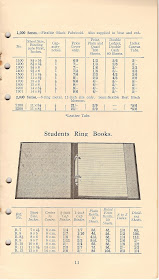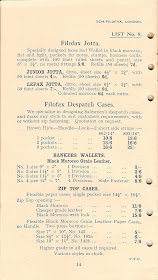So after yesterday's first half of our journey back in time, we continue today with the second half of our journey.
Thank you for all your feed back on yesterday's post, I'm not sure if we have come to a definitive conclusion yet on the date of the catalogue, but for the point of discussion I will use '1937'.
So consider this for a moment, irrespective of the date of the catalogue. Compare the price of an organiser with the price of a punch. The punch is just about the most expensive thing in the catalogue at £2, yet a leather organiser is £1/7/6 or £1.375 for 1 inch rings. Now in today's money the punch from Filofax will cost you £27.75 which would make the organiser in today's money about £19.08
Even my Winchester back in 1985 cost more than £19.00, remember the organisers where sold empty during the period of the catalogue and during the 1980's.
So what has changed... The cost of making a punch back in '1937' must have been considerably higher than today, I suspect the parts although made on a machine where made by a skilled metal worker and assembled by hand. These days and looking at the way the Filofax punch is now made the parts are most probably made using automated machinery. So that might account for some of the changes in price.... there is of course that horrible word 'profit' I suspect the profit margins on today's organisers are higher than they were back in say '1937'
The catalogues in the 1980's were not that different to this one, higher prices of course! But they also listed all the forms and inserts, quite baffling some of them. I will cross check the list against the ones shown in 'Filofax Facts' although that book was published in 1988, it will be interesting to see the differences. But there has definitely been quite a decline in the number of different inserts available.
If more information comes to light about the history and date of the catalogue I will be sure to let you know.
High resolution versions of the scans can be found here.










There are websites that will calculate UK inflation for any given amount and dates. So, the top of the range binder that was £1/7/6d (£1.375) in 1937 would now be £63.47. A Personal Malden at the current retail price of £72 (with contents) looks very similar.
ReplyDeleteWhat has changed is the outsourcing of all production to the Far East. This has saved massively on production costs and resulted in a big increase in mark-up on each item and overall profit for Filofax and parent company Letts, as the retail price hasn't been cut. It also leaves room for the regular discounting we often see and that would have been unheard of (and indeed impossible given low profit margins) in the 1930's.
On the other hand, if production hadn't moved out of the UK, we would certainly not have the vast range of different binders and sizes that we now enjoy and, Filofax may not have survived, let alone flourish!
Again, many thanks for posting this. It is fascinating naterial.
ReplyDeleteI guess most of us had our first contact with filofax etc., in the early to mid 80s.
Does anyone posess or has anyone seen any pre-80s binders, inserts etc.,? It would be really interesting to see the binders in particular. Thanks again.
Best Wishes
David
Really interesting & thanks for these 2 posts! I have a 30 year old Winchester & it makes me wonder how much it would have originally cost.
ReplyDeleteJust out of curiosity - page 14 of this second part of the catalogue. What is a banker's wallet?
ReplyDeleteBest Wishes
David
David
ReplyDeleteI think we need to consider in context what a Bankers Wallet might look like...
Think of an era with no bank cards or credit cards to carry. An era of bank notes that went from quite low values.
Pre decimalisation there was a 10 shilling note.
http://en.wikipedia.org/wiki/Bank_of_England_note_issues
So people would have been carrying more bank notes than these days, so I suspect that's what the 'divisions' refers to?
The Jotta on the same page is a like a leather note pad that you can slip in to your jacket pocket for quick note taking. Quite useful even today I would think. Anyone know if that are still available?
Steve
Steve,
ReplyDeleteThanks for posting the final details - it's intriguing to see how sophisticated things were all those years ago.
There are many 3x5-inch "jotta" type pads available from Levenger (shirt pocket briefcase) in the US and Smythson (pocket memo, as seen in The Da Vinci Code) in the UK, but I'm not aware of any that will hold Filofax Personal pages.
If there was any justice, a present-day bankers wallet would contain only moths :)
Gerard, Steve - I still have a couple of Filofax 'Jottas', which take Personal Size pages on one side only. It's comfortable with about 5 or 6 sheets in, no more.
ReplyDeleteI wore one out during the late 80s/early 90s. One of my current two is in pretty much mint condition and remains more or less unused, the other sees service pretty much every week - I carry it in my jacket pocket for taking notes when I'm out of my office.
Both of mine carry the marking "CLJ, Real Leather, Made in England.
I'm assuming the CL is Calf Leather.
I'm pretty sure these jottas are of the same era as the leather note/coin holders and chequebook holders.
Best Wishes
David
Best Wishes
David
The same style catalog from 1939 http://www.flickr.com/photos/filofaxuk/4635725454/in/set-72157624126176802.
ReplyDeleteIt carries the number ?38 on the top as opposed to the 137.
Great posts thanks Steve.
ReplyDeleteI've not had so much filo fun since I got the "Large Assortment" on ebay - a selection of one of each of the popular leaves from the late 1980s.
Looking at the cost comparisons, we should bear in mind that the Filofax Punch was disproportionately expensive compared to the rest of the range. In 1989 it cost £99, which is mighty expensive in today's prices and a huge sum back then. Admittedly it was a fairly heavy duty item, but I think it was priced high to ensure the consequent loss of revenue from purchased "official" leaves was mitigated somewhat.
@David F - great to hear that the jottas are still going strong in some quarters.
ReplyDeletep.s. Am I the only one who feels an irresistible urge to print out these scanned pages at the correct size, punch them and put them into a binder?
@abc def
ReplyDeleteThanks for the link, it's a shame that their scan isn't very high resolution.
Interesting details though Aldergate Street is the office that was bombed during WWII and the office that they lost all the records from.
Newgate Street the address on my catalogue is an adjacent street, look on Google Maps and you will see the two streets close to each other.
But yes I think a 1937 date would seem to be about right.
Thanks
Steve
An example of one of the wallets mentioned in the catalogue can be seen here.
ReplyDeletegmax - thank you for that link. That is quite a collection of vintage binders. I hadn't seen one of those travelfaxes before either.
ReplyDeleteBest Wishes
David